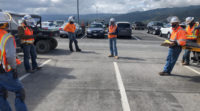Study Finds Excess Mortality for California Construction Laborers During Pandemic

A recent study by researchers at the University of California, San Francisco, found an excess number of deaths among all California working-age adults during the COVID-19 pandemic compared to past years—with construction laborers fifth highest in mortality rate.
“Our study places a powerful lens on the unjust impact of the COVID-19 pandemic on mortality of working age adults in different occupations,” says the study, which used California Dept. of Public Health death records to estimate mortality by certain occupational sectors and occupations for Californians between 18 and 65 years old, with rates further varying significantly by race and ethnicity.
The study has not yet completed peer review or publication, the researchers say.
The analysis forecast deaths from March 2020 through last October compared to historical periods and found that, during that time frame studied, mortality was 22% higher for working-age adults.
By occupation sectors based on U.S. Census data that the researchers focused on as "essential" workers, excess mortality rose 39% for workers classified in food and agriculture; 28% for those in transportation and logistics; 27% for those in chemicals, energy, water and other facilities—which the researchers said includes construction; and 23% in manufacturing.
The study reports that the facilities sector reported 1,681 excess California worker deaths, a 95% increase in the studied period.
In that same time frame, 1,587 construction laborer deaths were reported with a mortality risk-ratio of 1.49, which the study says is the observed number of deaths divided by the expected number. They ranked fifth among 25 worker occupational groups with the highest risk-ratios,
Among all worker occupations, Latino Californians experienced a 36% increase in excess mortality, with Blacks in the workforce at 28%, Asians at 18% and Whites at 6%.
“In person essential work is a likely venue of transmission of coronavirus infection and must be addressed through strict enforcement of health orders in workplace settings and protection of in-person workers,” according to the study. “Vaccine distribution prioritizing in-person essential workers will be important for reducing excess COVID mortality.”
Lead author Yea-Hung Chen, a university public health research data specialist, says the findings were not surprising, although she says that COVID-19 is inherently different than other health and safety risks with which owners and contractors are accustomed.
“If a worker suffers a hand injury, that injury can't be transmitted to other workers, and it also can't be transmitted to family members,” Chen told ENR. “With COVID-19, if one worker is sick, there is the very real possibility that multiple workers can become sick. There is also the possibility that the worker can transmit the illness to family members.”
The study notes that in-person essential workers are unique because they are not protected by stay-at-home policies. It adds that complementary policies are necessary to protect on-site workers, including free personal protective equipment, safety protocols, accessible testing, generous sick policies and workplace safety violation response.
“As jurisdictions struggle with difficult decisions regarding vaccine distribution, our findings offer a clear point of clarity," the analysis says. "Vaccination programs prioritizing workers in sectors such as food/agriculture are likely to have disproportionately large benefits for reducing COVID-19 mortality.”
Chen anticipates that the study’s peer review and publication process will complete in about two months.



